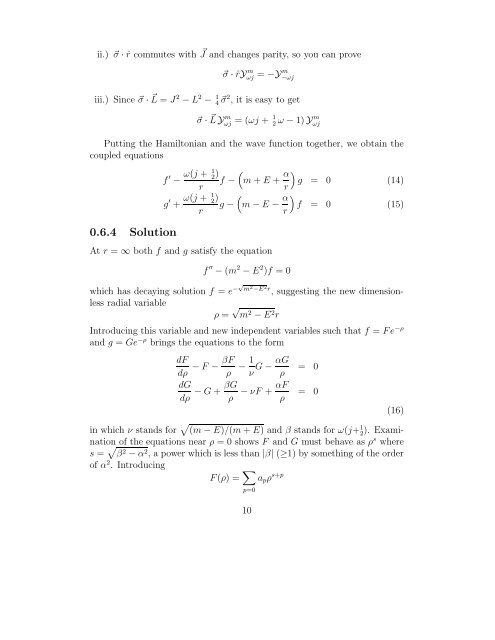0.1 Klein-Gordon Equation 0.2 Dirac Equation
0.1 Klein-Gordon Equation 0.2 Dirac Equation
0.1 Klein-Gordon Equation 0.2 Dirac Equation
You also want an ePaper? Increase the reach of your titles
YUMPU automatically turns print PDFs into web optimized ePapers that Google loves.
ii.) ⃗σ · ˆr commutes with ⃗ J and changes parity, so you can prove<br />
⃗σ · ˆrY m ωj = −Y m −ωj<br />
iii.) Since ⃗σ · ⃗L = J 2 − L 2 − 1 4 ⃗σ2 , it is easy to get<br />
⃗σ · ⃗L Y m ωj = (ωj + 1 2 ω − 1) Ym ωj<br />
Putting the Hamiltonian and the wave function together, we obtain the<br />
coupled equations<br />
0.6.4 Solution<br />
f ′ − ω(j + 1 2 )<br />
r<br />
g ′ + ω(j + 1 2 ) g −<br />
r<br />
At r = ∞ both f and g satisfy the equation<br />
(<br />
f − m + E + α )<br />
g = 0 (14)<br />
r<br />
(<br />
m − E − α )<br />
f = 0 (15)<br />
r<br />
f ′′ − (m 2 − E 2 )f = 0<br />
which has decaying solution f = e −√ m 2 −E 2r , suggesting the new dimensionless<br />
radial variable<br />
ρ = √ m 2 − E 2 r<br />
Introducing this variable and new independent variables such that f = F e −ρ<br />
and g = Ge −ρ brings the equations to the form<br />
dF<br />
dρ − F − βF ρ<br />
− 1 ν G − αG ρ<br />
dG<br />
dρ − G + βG ρ<br />
− νF + αF ρ<br />
= 0<br />
= 0<br />
(16)<br />
in which ν stands for √ (m − E)/(m + E) and β stands for ω(j+ 1 2 ). Examination<br />
of the equations near ρ = 0 shows F and G must behave as ρ s where<br />
s = √ β 2 − α 2 , a power which is less than |β| (≥1) by something of the order<br />
of α 2 . Introducing<br />
F (ρ) = ∑ a p ρ s+p<br />
p=0<br />
10
















